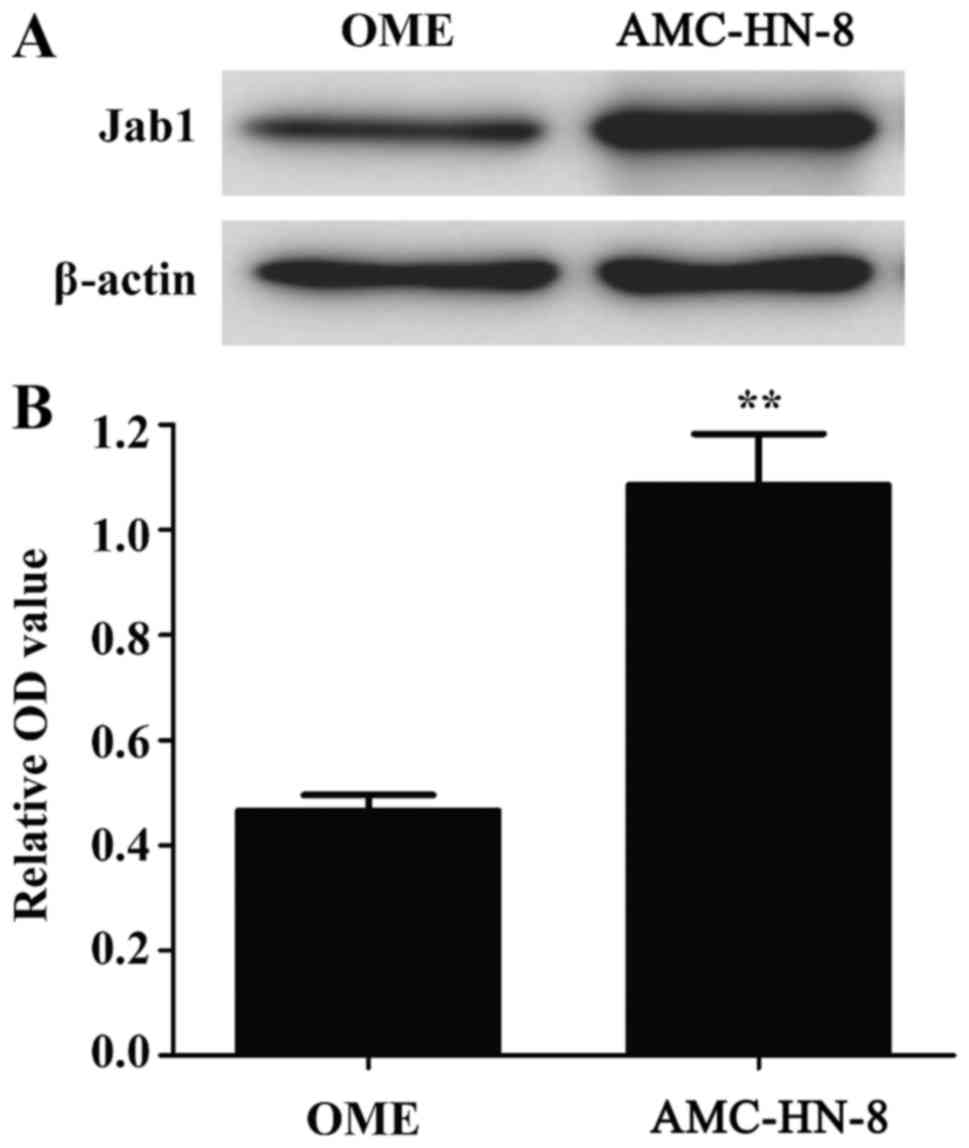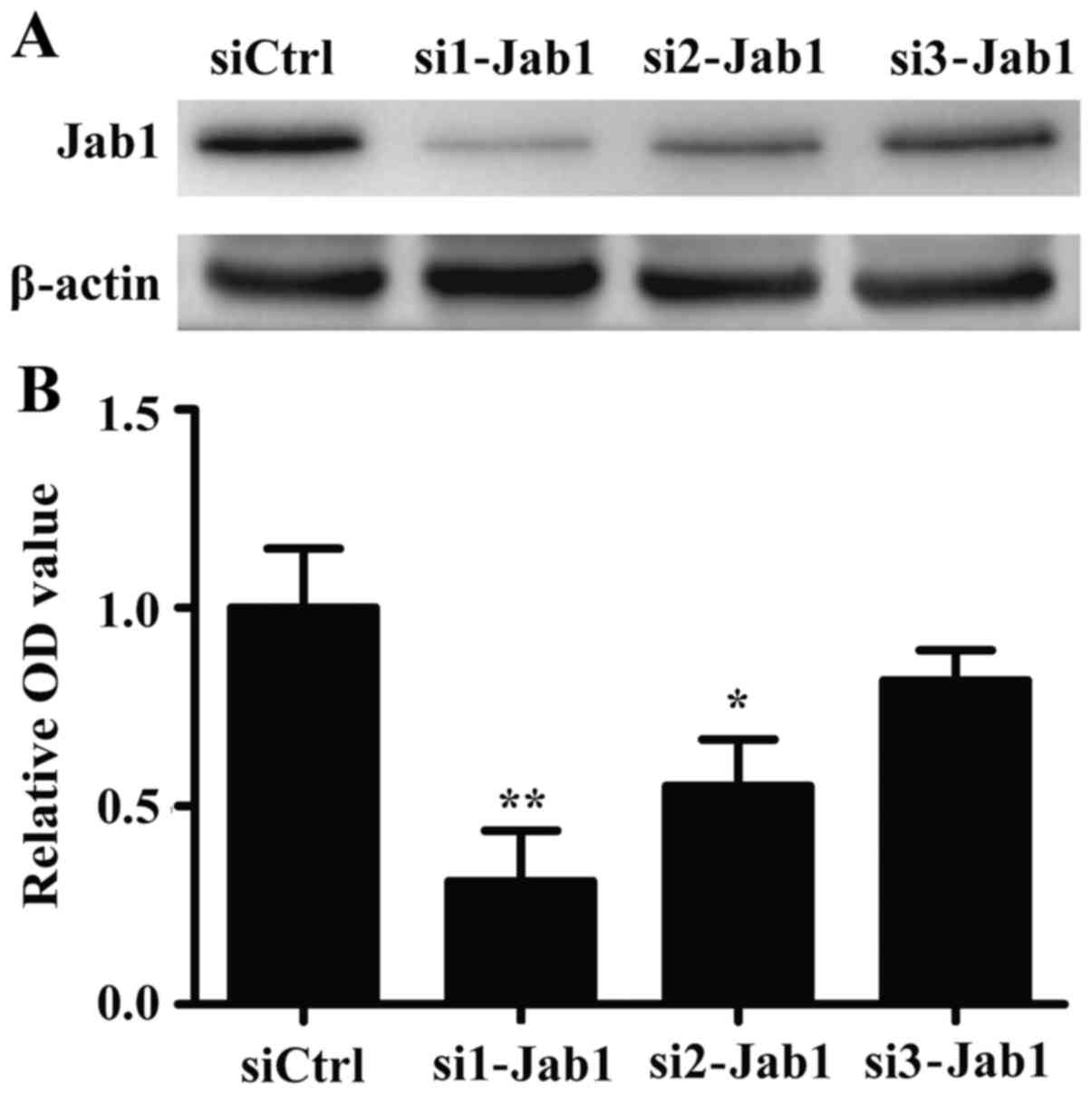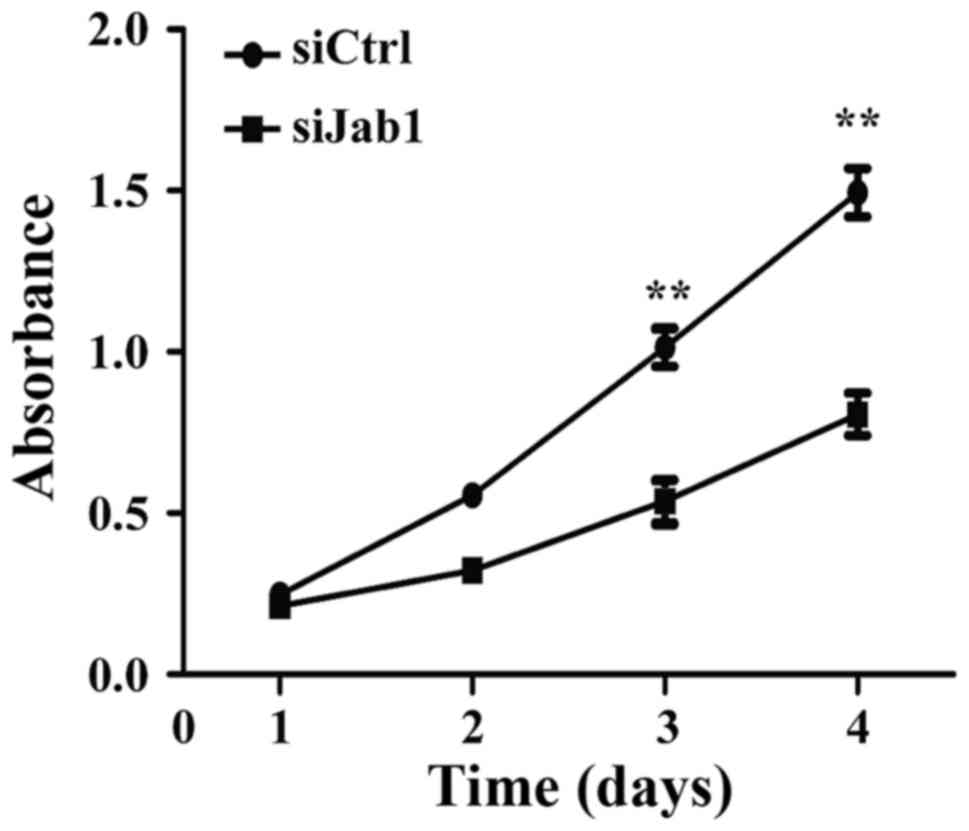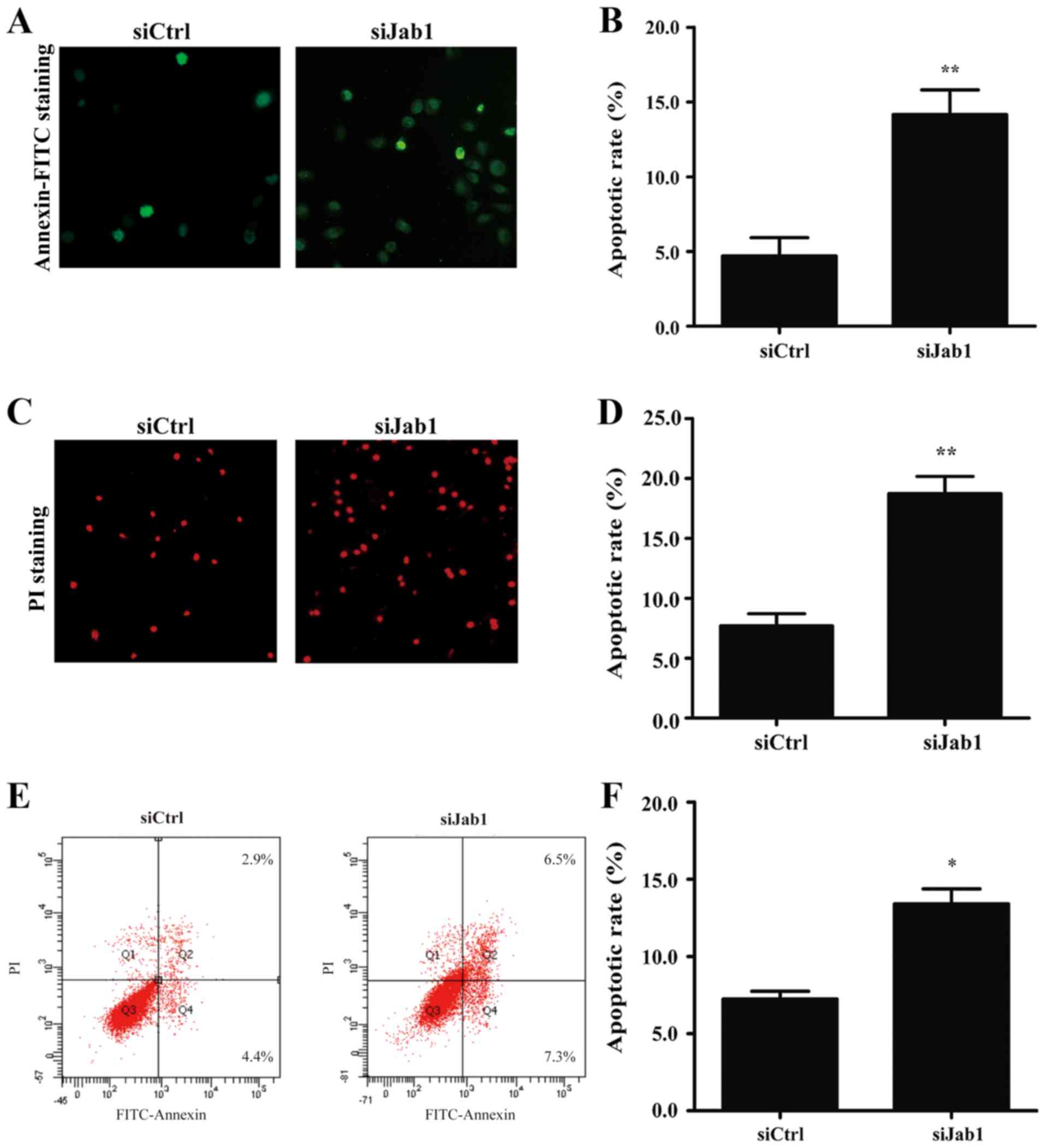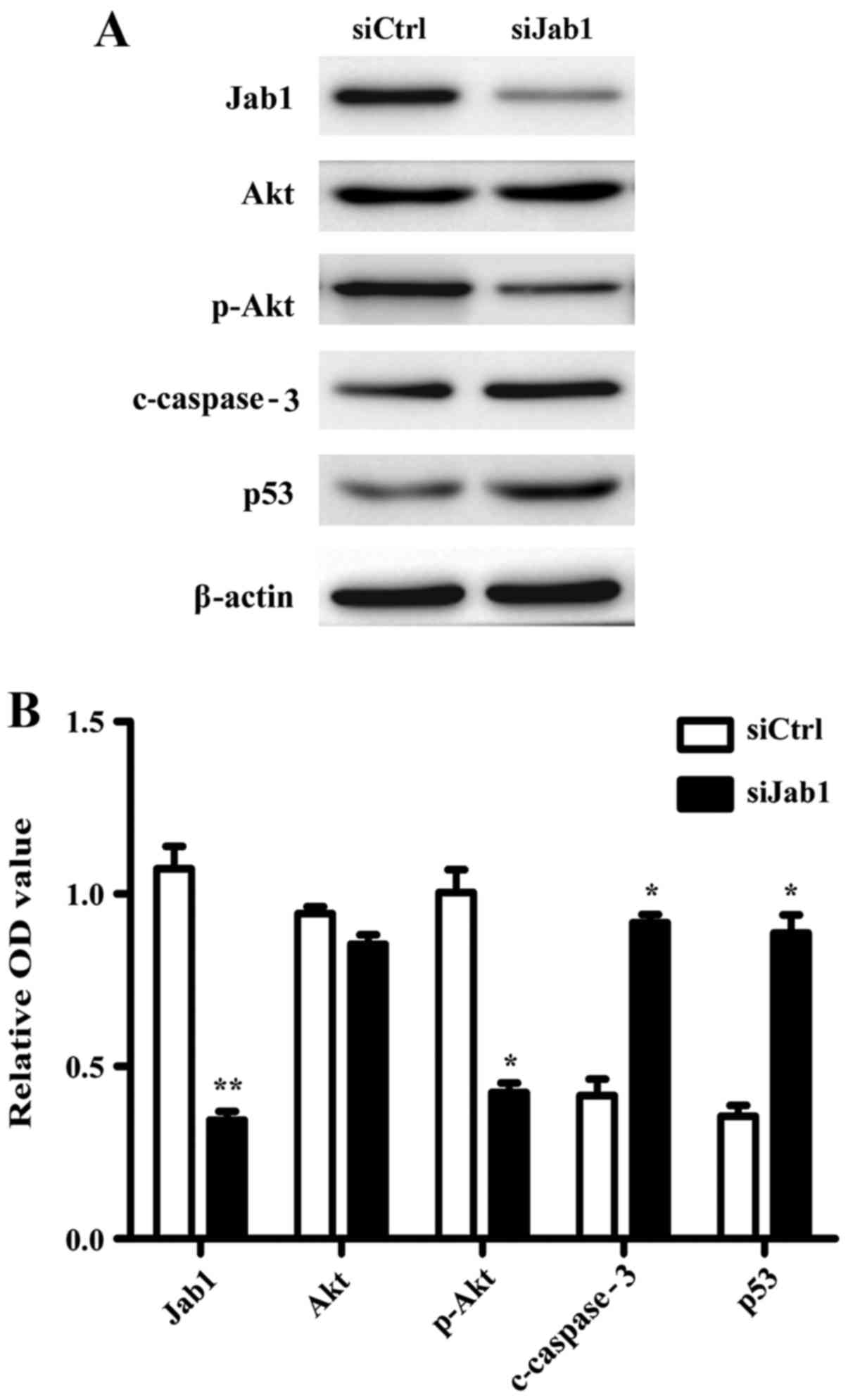Suppression of Jab1 expression inhibits proliferation and promotes apoptosis of AMC-HN-8 cells
- Authors:
- Published online on: February 6, 2018 https://doi.org/10.3892/ol.2018.7963
- Pages: 5137-5142
Abstract
Introduction
The constitutive photomorphogenesis 9 (COP9) signalosome complex (CSN) is composed of 8 subunits (CSN1-CSN8) and is involved in the development of eukaryotic organisms (1,2). CSN is a highly conserved protein complex that is involved in the regulation of cullin-RING family of ubiquitin ligases (CRLs) by mediating CRL deneddylation (3). The catalytic activity of CSN is performed by the CSN5 subunit. The Mpr1-Pad1-N (MPN) domain of CSN5 harbors a JAB1-MPN-MOV34 (JAMM) metalloenzyme motif (also known as the MPN+ motif), which is responsible for CRL deneddylation (4). Among the 8 subunits, CSN5 is unique, as it possesses the catalytic center of CSN isopeptidase activity and is also able to stably exist independently of the CSN (5). Although CSN5 was initially considered as a c-Jun coactivator, it is now known to be an integral subunit of the CSN. CSN5 is also referred to as c-Jun activation domain binding-protein-1 (Jab1) (6,7). It has been identified previously that the free form of Jab1 is cytoplasmic and nuclear, whereas CSN-associated Jab1 is mainly nuclear (8). Nevertheless, further studies are required to validate the function of Jab1, as a monomer or as a part of the CSN holocomplex, in the formation and progression of tumors.
Jab1 serves an essential function in cellular proliferation by directly interacting with and functionally regulating the activity and stability of several key intracellular regulatory proteins, including p53, p27, mothers against decapentaplegic homolog 4/7, macrophage migration inhibitory factor and hypoxia-inducible factor-1α (9–13). Although Jab1 participates in a number of regulatory processes, its function in tumorigenesis remains largely elusive. Indeed, Jab1 has an emerging function in cancer. Jab1 overexpression has been identified in various human malignancies and is inversely associated with a poor prognosis of patients with cancer (14). For example, the increased expression of Jab1 is detected in hepatocellular (15) and thyroid (16) carcinoma, and is associated with a lower survival rate.
Among the various types of head and neck cancer known, laryngeal squamous cell carcinoma (LSCC) remains a common type of cancer. There are >500,000 novel cases of LSCC diagnosed annually and the incidence of LSCC has increased in the last decade (17,18). It is frustrating that the mortality rate of patients with LSCC has not markedly decreased, regardless of whether the treatment strategy for LSCC has improved (19–21). Therefore, novel strategies and biomarkers are necessary for the treatment and tumor staging of LSCC.
In the present study, the expression levels of Jab1 in laryngeal cancer cells were examined. Furthermore, small interfering RNA (siRNA) was employed to analyze the function of Jab1 in regulating apoptosis and proliferation of laryngeal cancer cells in vitro. Finally, in order to investigate the underlying molecular mechanisms by which Jab1 is involved in LSCC, the expression levels of protein kinase B (Akt), phosphorylated (p)-Akt, p53 and cleaved caspase-3 (c-caspase-3) were examined in Jab1-knockdown cancer cells. The results of the present study suggest that Jab1 serves a crucial function in the progression of LSCC and may be a promising therapeutic target in combating LSCC.
Materials and methods
Cell culture conditions and siRNA transfection
AMC-HN-8 and OME cells were sourced from the Cell Bank, China Academy of Sciences (Shanghai, China) and maintained in Dulbecco's modified Eagle's medium (Gibco; Thermo Fisher Scientific, Inc., Waltham, MA, USA) supplemented with 10% fetal bovine serum (FBS; Invitrogen; Thermo Fisher Scientific, Inc.) and incubated in the Thermo forma incubator (Thermo Fisher Scientific, Inc.) at 37°C with 5% CO2. The cells were grown to 50% confluence. Cells were then transfected with three sets of Jab1-specific siRNAs (Shanghai GenePharma Co., Ltd., Shanghai, China) or negative control siRNA (siCtrl; Shanghai GenePharma Co., Ltd.), using siLentFect Lipid reagent (Bio-Rad Laboratories, Inc., Hercules, CA, USA). The quantity of the siRNAs used for transfection was 200 pmol for each 35 mm culture dish. The target sequences of the Jab1-specific siRNAs used were as follows: Jab1-siRNA1 (si1-Jab1) sense, 5′-CCAGACUAUUCCACUUAAUTT-3′ and antisense, 5′-AUUAAGUGGAAUAGUCUGGTT-3′; Jab1-siRNA2 (si2-Jab1) sense, 5′-GGUGAAACCAUGAUCAUUTT-3′ and antisense, 5′-UAAUGAUCAUGGUUUCACCTT-3′; Jab1-siRNA3 (si3-Jab1) sense, 5′-GGACUAAGGAUCACCAUUATT-3′ and antisense, 5′-UAAUGGUGAUCCUUAGUCCTT-3′.
At 4–6 h after transfection, the culture medium (DMEM) containing the transfection reagent was removed, and fresh medium containing FBS was added. After 48 h of culture, cells were lysed and used for subsequent experiments.
Western blot analysis
At 48 h after transfection with each si-Jab1, 1 ml of lysis buffer (Beyotime Institute of Biotechnology, Haimen, China) was added to each dish for 30 min at 4°C, with occasional shaking. Then, cell lysates were collected into a 1.5 ml tube followed with centrifugation at 16,000 × g for 15 min at 4°C. The protein concentration was determined using a bicinchoninic acid assay kit (Pierce; Thermo Fisher Scientific, Inc.). Total proteins were boiled with loading buffer (Vicmed Biotech Co., Ltd., Xuzhou, China) and then loaded (100 µg/lane) and separated by SDS-PAGE (12.5% gel) and transferred onto a nitrocellulose membrane. The membranes were then blocked for 2 h at room temperature in 5% non-fat milk (BD Biosciences, Franklin Lakes, NJ, USA) suspended in tris-buffered saline with Tween-20 (TBST; 150 mM NaCl, 20 mM Tris-HCl, pH 8.0, 0.05% Tween-20). Following blocking, the membranes were incubated with anti-cleaved caspase-3 (Cell Signaling Technology, Inc., Danvers, MA, USA), anti-Jab1, anti-p53, anti-Akt, anti-p-Akt and anti-β-actin (Santa Cruz Biotechnology, Inc., Dallas, TX, USA) antibodies at 4°C overnight. Membranes were then washed using TBST and incubated with the horseradish peroxidase-conjugated mouse anti-rabbit IgG secondary antibodies (cat no. A2074; 1:20,000; Sigma; Merck KGaA, Darmstadt, Germany) at room temperature for 2 h. The protein bands were visualized with Enhanced Chemiluminescence reagent (Tanon Science and Technology Co., Ltd., Shanghai, China). The densitometric analysis for the quantification of the bands was performed using ImageJ software (version 1.46; National Institutes of Health, Bethesda, MD, USA).
Cell proliferation assay
Cell proliferation was evaluated using a Cell Counting Kit-8 (CCK-8; Beyotime Institute of Biotechnology). In brief, at 48 h post-transfection, 5,000 cells were seeded in 96-well plates with medium containing 10% FBS and incubated for 1, 2, 3 and 4 days according to the manufacturer's protocol. Then, 10 µl CCK-8 solution and 100 µl serum-free culture medium (DMEM) were mixed and added to each well, followed by incubation at 37°C for 2 h. The absorbance was read at 450 nm using a spectrophotometer (BioTek Instruments, Inc., Winooski, VT, USA). The experiments were performed in triplicate.
Confocal analysis of Annexin V binding
AMC-HN-8 cells were plated in 6-well plates and transfected with si1-Jab1. si1-Jab1 was selected for this and subsequent experiments as it yielded the most marked decrease in Jab1 expression of all three Jab1-specific siRNAs. Following transfection, treated cells were collected in a 1.5 ml tube and washed twice with phosphate buffered saline. Following washing, cells were labeled with 200 µl binding buffer (BD Biosciences) containing 5 µl Annexin V-fluorescein isothiocyanate (FITC) and added to 300 µl binding buffer containing 5 µl propidium iodide (PI) at room temperature in darkness for 5 min. Cells were visualized under a fluorescence microscope (Olympus Corporation, Tokyo, Japan). The software used for analysis was Olympus cellSens Dimension (version 1.0; Olympus Corporation). A total of 3 independent experiments were conducted and 5 horizons were randomly selected from each group, at a magnification of ×100.
Flow cytometric analysis of apoptosis
AMC-HN-8 cells were plated in 6-well plates and transfected with si1-Jab1 for 48 h. The cells were collected and labeled using an Annexin V-FITC/PI Apoptosis Detection kit (BD Biosciences), according to the manufacturer's protocol. The apoptotic cell fraction was detected using a FACScan flow cytometer (BD Biosciences). Data were analyzed using ModFit LT 3.0 software (Verity Software House, Inc., Topsham, ME, USA). Living cells (Annexin V−FITC−/PI−), early apoptotic cells (Annexin V−FITC+/PI−), late apoptotic cells (Annexin V−FITC+/PI+) and necrotic cells (Annexin V−FITC−/PI+) were enumerated.
Statistical analysis
Data were analyzed using SPSS software (version 16.0; SPSS, Inc., Chicago, IL, USA). The relevant data are expressed as the mean ± standard deviation (SD). Results were analyzed using Student's t-test when only 2 groups were compared, or one-way analysis of variance when >2 groups were compared. The post hoc test used was the Student-Newman-Keuls method. P<0.05 was considered to indicate a statistically significant difference.
Results
Jab1 expression is increased in cancer cells
Western blot analysis was used to detect the expression of Jab1 in normal human oral mucosal epithelial (OME) and AMC-HN-8 cells. As presented in Fig. 1, the expression level of Jab1 protein was increased in AMC-HN-8 cells compared with OME cells, suggesting that, although Jab1 can be expressed in normal cells, its levels are increased in laryngeal cancer cells.
Knockdown of Jab1 inhibits cell proliferation and promotes apoptosis
Jab1 expression was knocked down in AMC-HN-8 cells using three different sets of siRNAs targeting Jab1 (si1-Jab1, si2-Jab1 and si3-Jab1). Jab1 protein expression was evaluated using western blot analysis and it was identified that Jab1 was significantly downregulated in si1-Jab1 and si2-Jab1 groups compared with the siCtrl group (Fig. 2). However, si1-Jab1 exhibited the most marked effect in decreasing the expression levels of Jab1 and was therefore used in subsequent experiments.
The effect of Jab1 on carcinoma cell proliferation was investigated. Following transfection of AMC-HN-8 cells with Jab1 siRNA, a CCK-8 assay was performed and a significant decrease in cellular proliferation was identified on days 3 and 4 (Fig. 3). This suggests that loss of Jab1 expression has an inhibitory effect on the proliferation of laryngeal cancer cells.
On the basis of the cell proliferation results, it was investigated whether the loss of Jab1 expression may also have an effect on the apoptosis of laryngeal cancer cells. An Annexin V-FITC binding assay and fluorescence microscopy were used to analyze changes in the total apoptotic cells including early apoptotic cells (Annexin V−FITC+/PI−) and late apoptotic or necrotic cells (Annexin V−FITC+/PI+). It was identified that the si1-Jab1-treated cells exhibited enhanced apoptosis at prophase (Fig. 4A and B) and anaphase (Fig. 4C and D) compared with the control group. Apoptosis was additionally analyzed between the two groups by flow cytometry. According to the results, it was observed that si1-Jab1 treatment increased the apoptotic cell fraction in AMC-HN-8 cells (Fig. 4E and F). In particular, the Annexin V−FITC+/PI− early apoptotic cell fraction accounted for 4.4% of the cells in the control and 7.3% of the cells in the si1-Jab1-treated group. Annexin V−FITC+/PI+ late apoptotic cells accounted for 2.9% of the cells in the control and 6.5% of the cells in the si1-Jab1 group, 48 h post-transfection. These results suggest that decreasing the expression of Jab1 protein facilitates the apoptosis of laryngeal cancer cells.
Effects of Jab1 downregulation on the expression of Akt and p53 protein
To understand the mechanisms involved in Jab1-mediated apoptosis and proliferation in carcinoma cells, the effect of Jab1 deficiency on certain key factors involved in anti-apoptotic pathways and the apoptotic cascade, including Akt, p-Akt, c-caspase-3 and p53, were examined. Western blot analysis revealed that the level of p-Akt expression was downregulated, whereas c-caspase-3 and p53 were upregulated in the Jab1-knockdown group in comparison with the control group (Fig. 5). These results indicate that these proteins may be involved in Jab1-mediated proliferation and apoptosis in AMC-HN-8 cells.
Discussion
A number of studies have demonstrated that Jab1 expression is increased in a number of human malignant tumors (9). Jab1 serves an intriguing function in the tumorigenic process and increased levels of Jab1 are associated with lymph node metastasis and poor prognosis of several types of human cancer, including LSCC. Jab1 may represent a prognostic indicator of malignant transformation and assists in explaining the biological behavior of a number of cancer cells, including human colorectal cancer cell lines (22) and liver cancer cells (23). It has been reported that Jab1 acts as a negative regulatory factor of p27 protein and has an association with cell proliferation in LSCC (24). However, the underlying molecular mechanism of Jab1 in LSCC is not known. In the present study, it was identified that AMC-HN-8 cells exhibit increased Jab1 expression levels when compared with OME cells. Additionally, it was demonstrated that downregulation of Jab1 inhibits proliferation and increases the apoptosis of laryngeal carcinoma cells. These results suggest that Jab1 may regulate the biological behavior of the LSCC cells and contribute to the progression of laryngeal carcinoma.
Free-form (non-CSN-associated) Jab1 is located in the cytoplasm and the nucleus, whereas CSN-associated Jab1 is primarily located in the nucleus (25). Jab1 protein is mainly localized in the nucleus in AMC-HN-8 cells (24). The Jab1 PMN domain contains the JAMM motif, which is essential for CSN deneddylation activity. The functional effects of Jab1 depend on the whole CSN assembly and deletion of any CSN subunit may lead to the inactivation of the CSN complex (26).
In the present study the function of Jab1 on apoptosis, a complex biological process (27), during LSCC progression was evaluated. For this purpose, the expression levels of caspase-3 and p53 were determined in laryngeal cancer cells, with downregulated Jab1 expression. Caspase-3 is an effector caspase involved in the apoptotic cascade (28). According to the results of the present study, c-caspase-3 exhibited a significant increase following Jab1 downregulation in AMC-HN-8 cells. Additionally, p53 was identified to be upregulated following si1-Jab1 transfection. p53 is a tumor-inhibiting factor that is able to limit cell proliferation by inducing apoptosis, and a number of apoptosis-related genes are transcriptionally regulated by p53 (29,30). Although c-caspase-3 and p53 are involved in Jab1-mediated apoptosis, it remains to be determined whether there is a connection between p53 and c-caspase-3. According to the results presented in Fig. 5A, p53 and c-caspase-3 were identified to be upregulated following si1-Jab1 transfection. Therefore, it was hypothesized that there may exist a positive association between p53 and c-caspase-3. Finally, it was identified that the expression level of p-Akt was decreased following si1-Jab1 transfection. On the basis of the significant function of Akt in cellular proliferation (31), it is likely that Jab1 siRNA inhibits cell proliferation via the phosphoinositide 3-kinase/Akt signaling pathway.
In summary, the results of the present study demonstrate that Jab1 serves a crucial function in LSCC tumorigenesis, particularly in cellular proliferation and apoptosis. Jab1 is critical for the regulation of Akt, c-caspase-3 and p53. Further experiments remain to be performed to elucidate the underlying molecular mechanisms by which Jab1 regulates proliferation and apoptosis during tumorigenesis. Jab1 is likely to be a key marker and target for the treatment of LSCC.
Acknowledgements
The present study was supported by the National Natural Science Foundation of China (grant no. 81572349), Jiangsu Provincial Medical Talent, and the Science and Technology Department of Jiangsu Province (grant nos. BK20130231 and BK20141149).
References
|
Kapelari B, Bech-Otschir D, Hegerl R, Schade R, Dumdey R and Dubiel W: Electron microscopy and subunit-subunit interaction studies reveal a first architecture of COP9 signalosome. J Mol Biol. 300:1169–1178. 2000. View Article : Google Scholar : PubMed/NCBI | |
|
Wei N, Serino G and Deng XW: The COP9 signalosome: More than a protease. Trends Biochem Sci. 33:592–600. 2008. View Article : Google Scholar : PubMed/NCBI | |
|
Schwechheimer C and Deng XW: COP9 signalosome revisited: A novel mediator of protein degradation. Trends Cell Biol. 11:420–426. 2001. View Article : Google Scholar : PubMed/NCBI | |
|
Cope GA, Suh GS, Aravind L, Schwarz SE, Zipursky SL, Koonin EV and Deshaies RJ: Role of predicted metalloprotease motif of Jab1/Csn5 in cleavage of Nedd8 from Cul1. Science. 298:608–611. 2002. View Article : Google Scholar : PubMed/NCBI | |
|
Wei N and Deng XW: The COP9 signalosome. Annu Rev Cell Dev Biol. 19:261–286. 2003. View Article : Google Scholar : PubMed/NCBI | |
|
Claret FX, Hibi M, Dhut S, Toda T and Karin M: A new group of conserved coactivators that increase the specificity of AP-1 transcription factors. Nature. 383:453–457. 1996. View Article : Google Scholar : PubMed/NCBI | |
|
Chamovitz DA and Segal D: JAB1/CSN5 and the COP9 signalosome. A complex situation. EMBO Rep. 2:96–101. 2001. View Article : Google Scholar : PubMed/NCBI | |
|
Kwok SF, Solano R, Tsuge T, Chamovitz DA, Ecker JR, Matsui M and Deng XW: Arabidopsis homologs of a c-Jun coactivator are present both in monomeric form and in the COP9 complex, and their abundance is differentially affected by the pleiotropic cop/det/fus mutations. Plant Cell. 10:1779–1790. 1998. View Article : Google Scholar : PubMed/NCBI | |
|
Shackleford TJ and Claret FX: JAB1/CSN5: A new player in cell cycle control and cancer. Cell Div. 5:262010. View Article : Google Scholar : PubMed/NCBI | |
|
Winner M, Koong AC, Rendon BE, Zundel W and Mitchell RA: Amplification of tumor hypoxic responses by macrophage migration inhibitory factor-dependent hypoxia-inducible factor stabilization. Cancer Res. 67:186–193. 2007. View Article : Google Scholar : PubMed/NCBI | |
|
Oh W, Lee EW, Sung YH, Yang MR, Ghim J, Lee HW and Song J: Jab1 induces the cytoplasmic localization and degradation of p53 in coordination with Hdm2. J Biol Chem. 281:17457–17465. 2006. View Article : Google Scholar : PubMed/NCBI | |
|
Wan M and Cao X, Wu Y, Bai S, Wu L, Shi X, Wang N and Cao X: Jab1 antagonizes TGF-beta signaling by inducing Smad4 degradation. EMBO Rep. 3:171–176. 2002. View Article : Google Scholar : PubMed/NCBI | |
|
Tomoda K, Kubota Y, Arata Y, Mori S, Maeda M, Tanaka T, Yoshida M, Yoneda-Kato N and Kato JY: The cytoplasmic shuttling and subsequent degradation of p27Kip1 mediated by Jab1/CSN5 and the COP9 signalosome complex. J Biol Chem. 277:2302–2310. 2002. View Article : Google Scholar : PubMed/NCBI | |
|
Kato JY and Yoneda-Kato N: Mammalian COP9 signalosome. Genes Cells. 14:1209–1225. 2009. View Article : Google Scholar : PubMed/NCBI | |
|
Hsu MC, Huang CC, Chang HC, Hu TH and Hung WC: Overexpression of Jab1 in hepatocellular carcinoma and its inhibition by peroxisome proliferator-activated receptor{gamma} ligands in vitro and in vivo. Clin Cancer Res. 14:4045–4052. 2008. View Article : Google Scholar : PubMed/NCBI | |
|
Ahn J, Hong SA, Lee SE, Kim J, Oh YS, Park SJ and Chung YJ: Cytoplasmic localization of Jab1 and p27 Kip1 might be associated with invasiveness of papillary thyroid carcinoma. Endocr J. 56:707–713. 2009. View Article : Google Scholar : PubMed/NCBI | |
|
Jemal A, Siegel R, Ward E, Hao Y, Xu J and Thun MJ: Cancer statistics, 2009. CA Cancer J Clin. 59:225–249. 2009. View Article : Google Scholar : PubMed/NCBI | |
|
Liu XK, Li Q, Xu LH, Hu LJ, Liao WG, Zhang XR, Liu ZM, Wu D and Zeng MS: Expression and clinical significance of SIAH in laryngeal squamous cell carcinoma. Med Oncol. 30:4852013. View Article : Google Scholar : PubMed/NCBI | |
|
Boyle P and Ferlay J: Cancer incidence and mortality in Europe, 2004. Ann Oncol. 16:481–488. 2005. View Article : Google Scholar : PubMed/NCBI | |
|
Ferlay J, Parkin DM and Steliarova-Foucher E: Estimates of cancer incidence and mortality in Europe in 2008. Eur J Cancer. 46:765–781. 2010. View Article : Google Scholar : PubMed/NCBI | |
|
Li JJ, Yang XM, Wang SH and Tang QL: Prognostic role of epidermal growth factor-like domain 7 protein expression in laryngeal squamous cell carcinoma. J Laryngol Otol. 125:1152–1157. 2011. View Article : Google Scholar : PubMed/NCBI | |
|
Schütz AK, Hennes T, Jumpertz S, Fuchs S and Bernhagen J: Role of CSN5/JAB1 in Wnt/β-catenin activation in colorectal cancer cells. FEBS Lett. 586:1645–1651. 2012. View Article : Google Scholar : PubMed/NCBI | |
|
Lee YH, Judge AD, Seo D, Kitade M, Gómez-Quiroz LE, Ishikawa T, Andersen JB, Kim BK, Marquardt JU, Raggi C, et al: Molecular targeting of CSN5 in human hepatocellular carcinoma: A mechanism of therapeutic response. Oncogene. 30:4175–4184. 2011. View Article : Google Scholar : PubMed/NCBI | |
|
Dong Y, Sui L, Watanabe Y, Yamaguchi F, Hatano N and Tokuda M: Prognostic significance of Jab1 expression in laryngeal squamous cell carcinomas. Clin Cancer Res. 11:259–266. 2005.PubMed/NCBI | |
|
Tomoda K, Kubota Y and Kato J: Degradation of the cyclin-dependent-kinase inhibitor p27Kip1 is instigated by Jab1. Nature. 398:160–165. 1999. View Article : Google Scholar : PubMed/NCBI | |
|
Adler AS, Littlepage LE, Lin M, Kawahara TL, Wong DJ, Werb Z and Chang HY: CSN5 isopeptidase activity links COP9 signalosome activation to breast cancer progression. Cancer Res. 68:506–515. 2008. View Article : Google Scholar : PubMed/NCBI | |
|
Thompson CB: Apoptosis in the pathogenesis and treatment of disease. Science. 267:1456–1462. 1995. View Article : Google Scholar : PubMed/NCBI | |
|
Porter AG and Jänicke RU: Emerging roles of caspase-3 in apoptosis. Cell Death Differ. 6:99–104. 1999. View Article : Google Scholar : PubMed/NCBI | |
|
Shen Y and White E: p53-dependent apoptosis pathways. Adv Cancer Res. 82:55–84. 2001. View Article : Google Scholar : PubMed/NCBI | |
|
Abu-Qare AW and Abou-Donia MB: Biomarkers of apoptosis: Release of cytochrome c, activation of caspase-3, induction of 8-hydroxy-2′-deoxyguanosine, increased 3-nitrotyrosine, and alteration of p53 gene. J Toxicol Environ Health B Crit Rev. 4:313–332. 2001. View Article : Google Scholar : PubMed/NCBI | |
|
Cicenas J: The potential role of Akt phosphorylation in human cancers. Int J Biol Markers. 23:1–9. 2008. View Article : Google Scholar : PubMed/NCBI |



